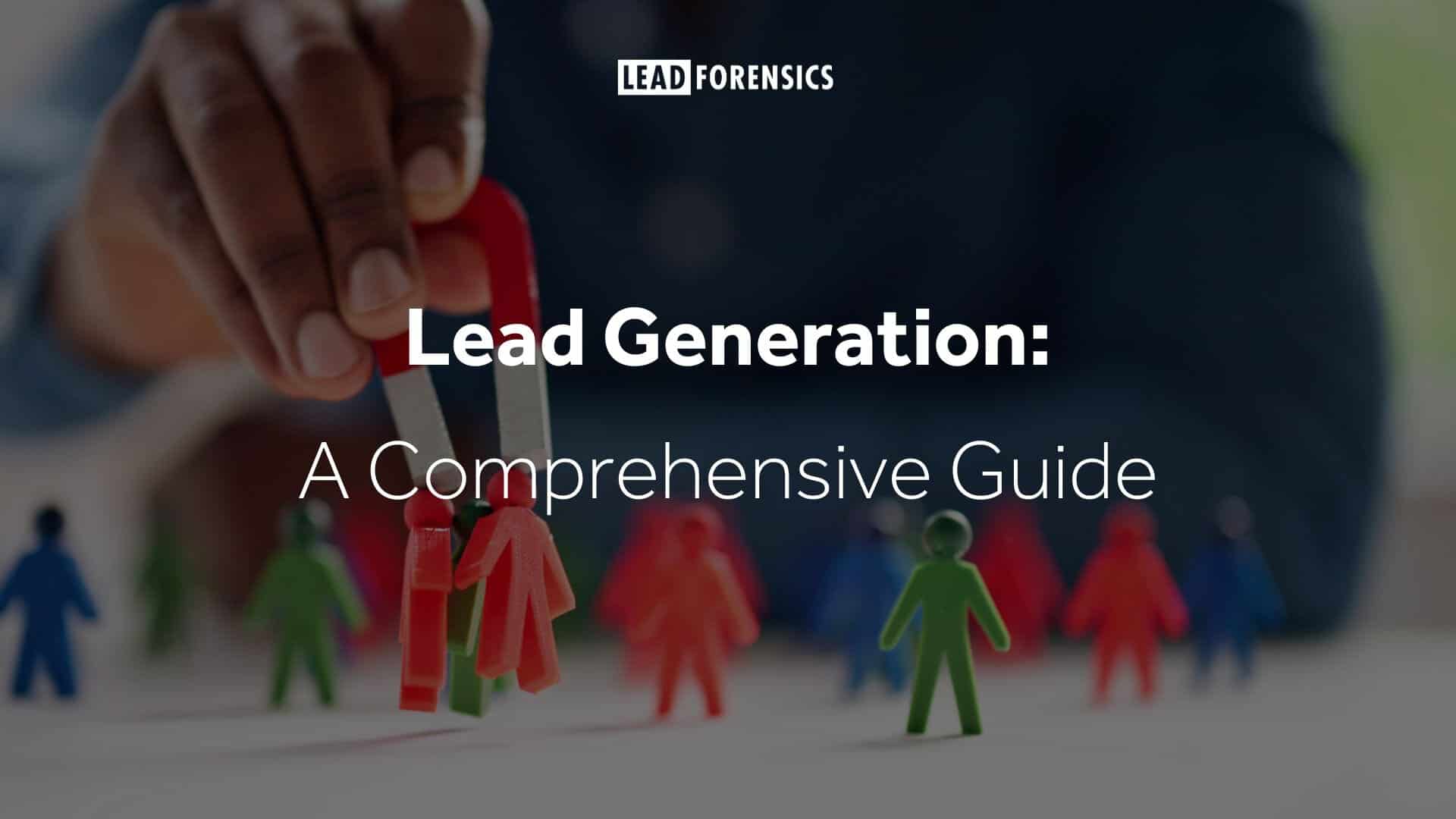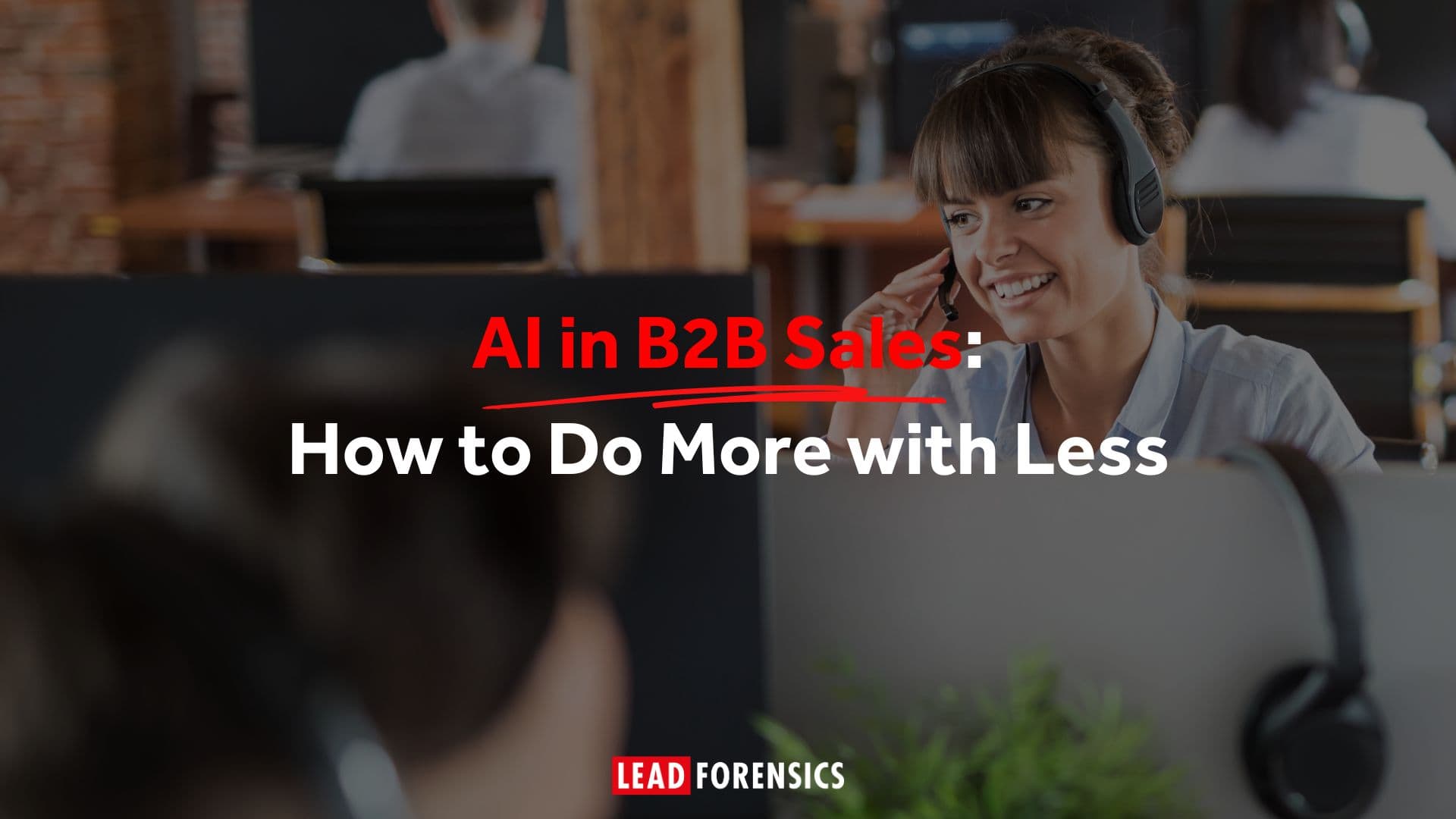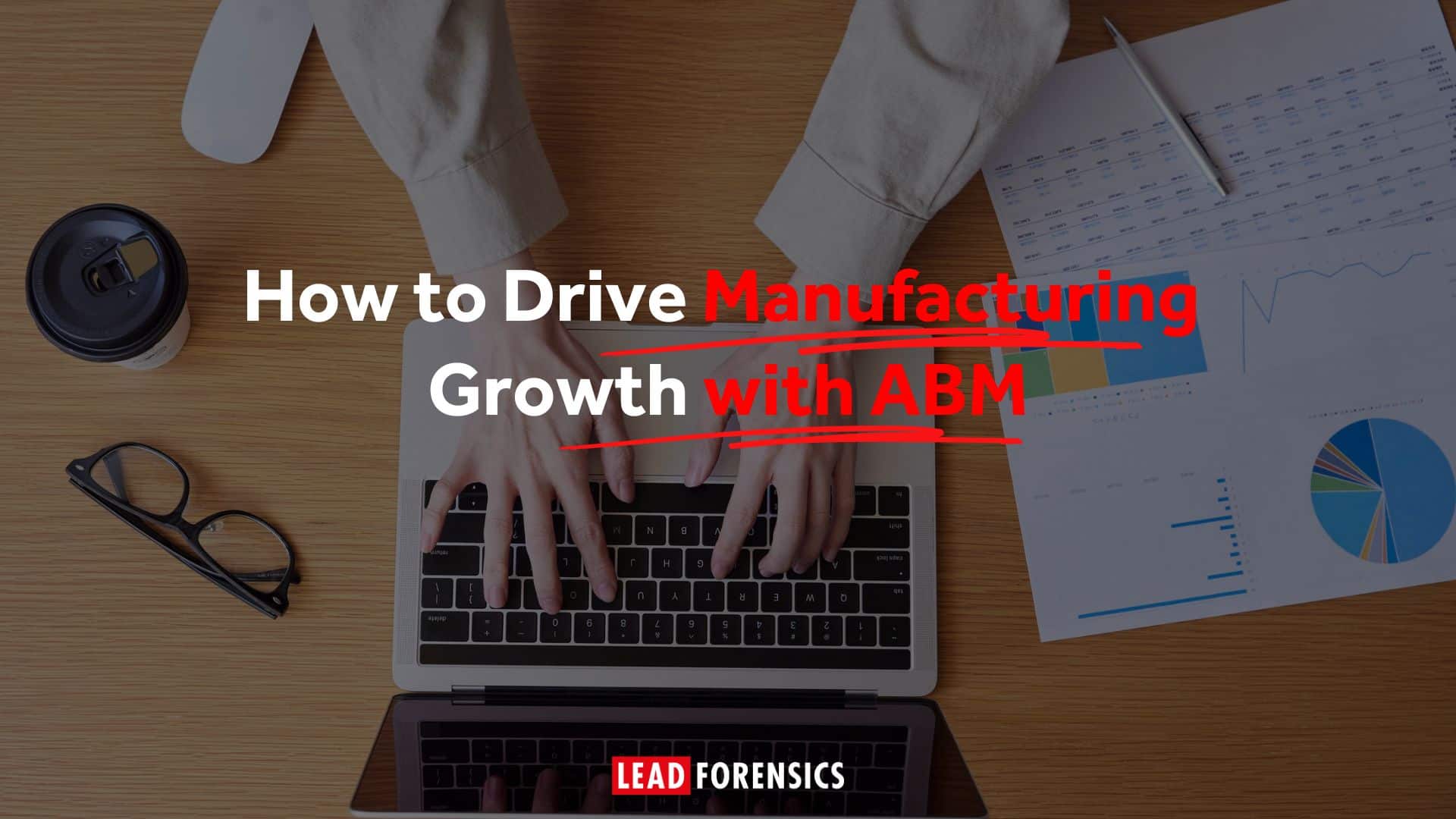Effective lead generation isn’t about volume, it’s about identifying revenue-qualified opportunities that can be attributed back to specific marketing efforts. After all, that’s what today’s CMOs are accountable for.
Jump to:
- What is Lead Generation?
- Why is Lead Generation Important?
- What Are The Main Types of B2B Leads?
- Who’s Responsible for Lead Generation?
- Inbound Vs Outbound Lead Generation
- What Is the B2B Lead Generation Process?
- How Do Marketing Teams Generate Leads?
- How Do Sales Teams Generate Leads?
- How Can You Improve Your Lead Generation?
- What Lead Generation Tools Can Help?
- What Is The Future Of B2B Lead Gen?
What is Lead Generation?
B2B lead generation is the strategic process of identifying, attracting and converting prospects that fit your ideal customer profile (ICP) into qualified sales opportunities. Unlike high‑volume consumer lead generation, B2B lead gen emphasises quality over quantity. It’s about fuelling your revenue engine with the right leads who are likely to become customers.
High-performing marketing leaders focus their lead gen marketing on:
- Finding qualified sales leads that are aligned with their ICP
- Analyzing and understanding how their lead gen campaigns perform with clear attribution
- Aligning their team with sales to increase conversion velocity
- Tapping into lifecycle intelligence to accelerate handoffs
According to HubSpot’s State of Marketing Report, 61% of marketers consider lead generation their top challenge.
But the real issue isn’t volume, it’s visibility.
Ask yourself if your lead gen marketing includes visibility of which leads are actually progressing toward revenue and an understanding of which channels create the highest-converting opportunities. If it doesn’t, you’re likely overspending, under-converting, and under-reporting your impact.
Why is Lead Generation Important?
Without leads, there are no sales. Without sales, there is no revenue. But B2B lead generation ensures a steady pipeline of prospects. It’s the lifeblood of any company looking to expand, secure long-term clients, and stay ahead of the competition.
Here’s why lead gen marketing in B2B is so important:
- It sustains business growth. A steady flow of leads ensures continuous revenue.
- It enhances your sales efficiency. When sales teams focus on high-quality sales leads, conversion rates
- It builds brand authority. By attracting businesses interested in your niche, you establish industry credibility.
- It improves ROI. Targeted lead generation campaigns minimize wasted efforts and maximizes marketing spend.
Almost half of professionals said generating enough leads to meet B2B sales targets was a real challenge in 2024, according to Sopro’s State of Prospecting research.
What Are The Main Types of B2B Leads?
Leads can be categorised based on how ready they are to buy:
- Marketing Qualified Leads (MQLs). These B2B leads have engaged with your brand through marketing activities like downloading content or attending webinars. They’re not ready to buy just yet, but they already have a relationship with your business, so they’d be considered a warm lead and contacted via warm calling.
- Sales Qualified Leads (SQLs). These prospects have shown strong buyer intent signals and they’re in contact with the sales team, who are actively engaging with them to convert them into a customer.
- Cold Leads. These prospects have had little to no engagement with your brand, but they fit your ICP, so they’re being contacted through cold calling, LinkedIn outreach and other multi-channel marketing campaigns.
Who’s Responsible for Lead Generation?
The process of generating leads isn’t a one-person job, it’s a collaborative effort.
Different teams work to generate B2B leads, nurture them, close the sale and then retain them:
- Marketing teams create and execute strategies to attract leads through content marketing, paid ads, and social media.
- Sales teams qualify leads, conduct outreach, and close deals.
- Customer success teams upsell and retain clients, turning them into long-term customers.
Your lead generation strategies need to make sure each of these departments are aligned and working well together, since they’re all part of one big process.
Inbound Vs Outbound Lead Generation
There are two main types of lead gen marketing: inbound and outbound.
Inbound is when a prospect comes to you. They’ll be targeted with tactics like content marketing, social media, and paid advertising that are designed to lure them onto your website.
Conversely, outbound is when you reach out to the prospect. It’s usually done through cold calling or sales outreach emails and messaging.
While inbound drives long-term scalability, outbound remains critical for accelerating pipeline creation and targeting in-market buyers. A high-performance lead gen marketing strategy blends both, with attribution guiding investment and any strategy changes down the line.
What Is the B2B Lead Generation Process?
There’s a typical process when it comes to generating leads:
- Identify target audience. Define your ideal customer profiles (ICPs) based on industry, company size, and pain points.
- Generate leads. Use inbound (content, SEO) and outbound (cold calling, email) strategies.
- Nurture leads. Provide valuable content, demos, and consultations to move prospects down the funnel.
- Score and qualify leads. Assign lead scores based on engagement level and readiness to buy.
- Handoff to sales. Ensure smooth transition from marketing to sales teams for closing deals.
- Measure and optimize. Continuously analyze your performance and tweak strategies for better results.
How Do Marketing Teams Generate Leads?
Marketing teams are often focused on inbound online lead generation. There are some essential tactics used to generate B2B leads through growth hacking and other marketing activities:
- Content marketing. Engaging content, compelling social media posts or interesting case studies are just some examples of how content can entice people to check out your website and even leave their contact details.
- LinkedIn and social selling. By reaching out to decision makers with personalized messages, B2B marketers can expand their networks and find new leads.
- Email marketing. Personalized email campaigns help to nurture leads and drive engagement with your content. This keeps them warm until they show signs that they’re ready to buy.
- Paid advertising. Tactics like Google Ads, LinkedIn Ads and retargeting campaigns can find people who display high buying intent and send them to the most valuable sales pages on your website.
- SEO and organic search. By optimizing your site for online searches, you’ll build solid foundations for long-term inbound lead generation campaigns and attract high quality leads.
- Webinars and events. These live sessions are a great way to bring your brand to life, demonstrate your expertise and build trust.
How Do Sales Teams Generate Leads?
B2B sales teams are typically focused on outbound lead gen—but some teams will also handle inbound leads, too.
The main ways that sales teams focus on generating leads are:
- Cold calling. By working through a list of contacts, the sales team speaks to a huge number of prospective businesses to make them aware of the company. It takes a lot of calls to convert customers, but it’s still a useful tactic.
- Email prospecting. When you can’t reach someone on the phone, they’ll often receive a personalized email instead. This gives the sales rep another opportunity to introduce the company and its products or services.
- Social selling. Using platforms like LinkedIn to engage with prospects and share sales messaging is another way that sales teams can find their own leads.
- Inbound lead handling. When someone fills out a contact form, requests a demo or is flagged as a hot lead, the sales team will reach out to them and try to help move them through the sales pipeline.
How Can You Improve Your Lead Generation?
Lead generation is a very broad topic, and the tactics that work can vary by business or industry. If you want to start getting more leads, the first thing you need to do is understand your lead gen metrics and review your current performance.
You want to see if there are any specific activities that get good conversion rates and identify those that are under-performing. Evaluate high-impact metrics like cost-per-opportunity (CPO), lead-to-opportunity conversion rate, influenced pipeline revenue, time-to-SQL, and MQL-to-close ratio.
You can also use our revenue calculator to find out how many leads you could be missing from your website how this impacts your revenue.
It’s a good idea to check if you’ve tested the most successful lead gen strategies, too. These include:
- Content marketing, like blogs, email and social media posting.
- On-page SEO to attract people who are searching for your kind of product or service already.
- Referral marketing, with reward schemes to incentivize existing customers to recommend you to their peers.
- Lead nurturing through things like email drip campaigns or personalized content.
- Live chat to help prospects find the right information or speak to a sales person quicker.
If you find that your marketing activities bring enough people to your website, but you’re just not converting them into leads, you should also look into how conversion rate optimization can help you drive success.
Some quick wins for CRO include:
- Optimize your forms to remove any friction and encourage more completions.
- Refine your call-to-action wording, design and placement.
- Publish hyper specific landing pages that focus on just one action from your website visitors.
- Test personalizing content and CTAs to specific industries or businesses.
Another way to generate more B2B leads is with visitor identification software. Tools like Lead Forensics can tell you which companies are visiting your website and what pages they look at. This helps you find warm prospects you’d never be aware of otherwise, and come up with ideas of how to tailor your outbound calls.
What Lead Generation Tools Can Help?
You’ll be able to get more leads, and do more with them, if you can embrace the latest technologies. Some of the most essential lead gen tools include:
- CRM software (e.g., HubSpot, Salesforce). This kind of software organizes your leads, tracks interactions, and automates outreach.
- Marketing automation (e.g., Marketo, Pardot). These tools streamline lead nurturing through email and workflows.
- Lead intelligence software (e.g., Lead Forensics). These identify your anonymous B2B website visitors and give you contact details of decision makers from those businesses.
- Chatbots & AI assistants (e.g., Salesloft, Whizeo). This type of tool engages prospects 24/7 and captures leads instantly.
- LinkedIn Sales Navigator. Specific to the social platform, Sales Navigator enhances LinkedIn prospecting and outreach.
Using the right tech stack makes your lead generation campaign more efficient and scalable.
What Is The Future Of B2B Lead Gen?
The latest B2B lead generation trends in 2025 are centered around AI and machine learning. They include things like:
- AI-powered lead scoring: machine learning will improve the accuracy of lead qualification.
- Hyper-personalization: generic emails won’t cut it; personalized messaging will drive results.
- Interactive content: quizzes, calculators, and interactive case studies will engage prospects better.
- ABM (account-based marketing) growth: companies are focusing more on targeting high-value accounts.
Need More Lead Gen Inspiration?
Discover how CSI Ltd increased their lead generation by 650% and generated $2.5m in additional revenue using Lead Forensics.
Want to try for yourself? Claim your free trial now.






